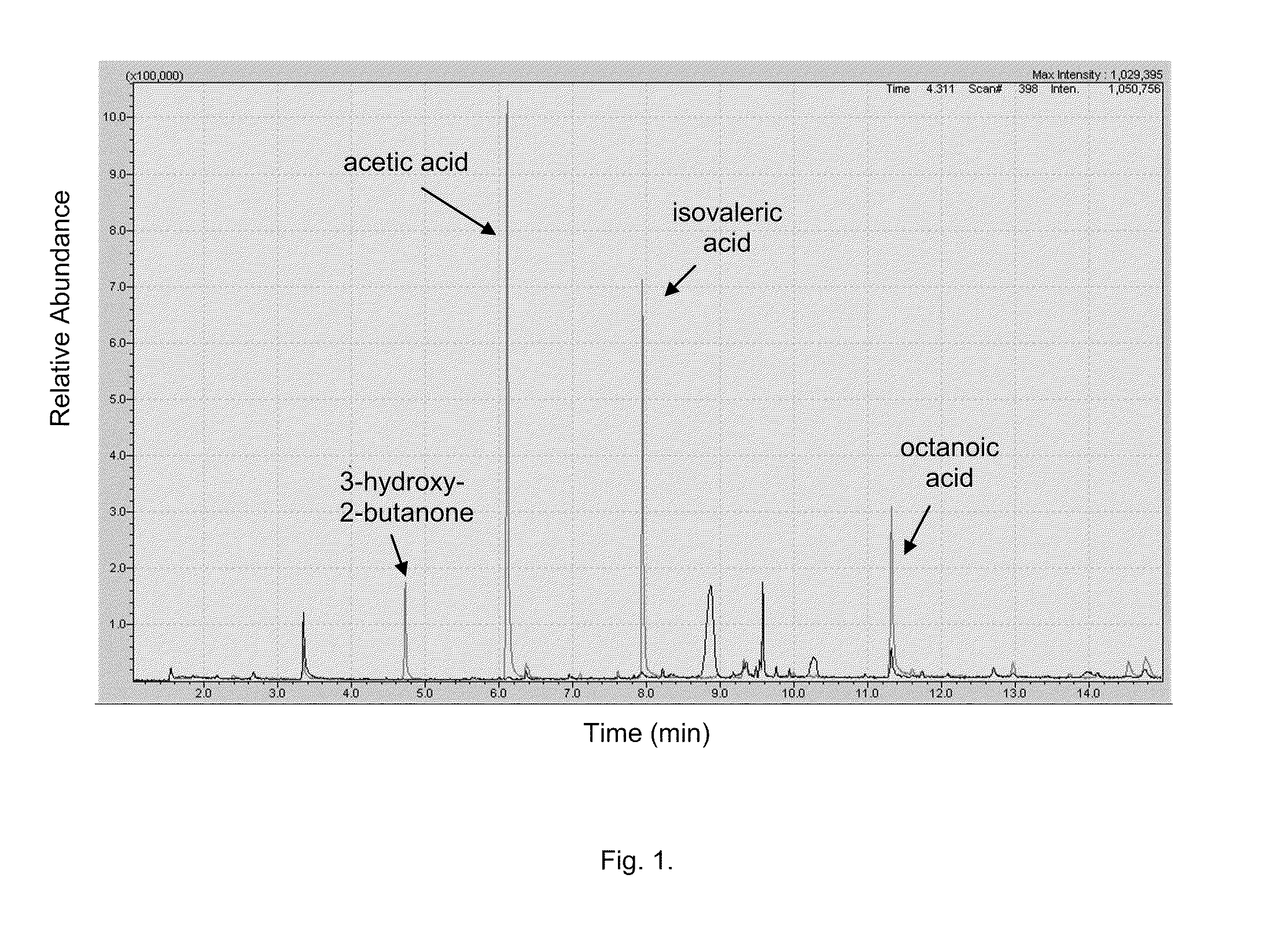Methods and Compositions for Reducing Body Odor
a technology of body odor and composition, applied in the field of biocontrol of odor-causing bacteria, can solve the problems of body odor, unpleasant odor, bacterial production of volatiles, etc., and achieve the effect of inhibiting the production of body malodormalodor
- Summary
- Abstract
- Description
- Claims
- Application Information
AI Technical Summary
Benefits of technology
Problems solved by technology
Method used
Image
Examples
example 1
Initial Zone of Inhibition Experiments
Introduction
[0039]The present invention arose from an effort to produce a product that would inhibit growth of Corynebacterium in the human axilla with effectiveness in a deodorant or other personal care composition. In Taylor, D., et al., “Characterization of the microflora of the human axilla,”International Journal of Cosmetic Science, 25:137-145 (2003), aerobic coryneforms were shown to have a ρ value of World Journal of Microbiology and Biotechnology, 20:787-793 (2004), proposed the metabolic pathways used by aerobic coryneforms that would generate malodor.
Methods
Media and Strains
[0040]Based on demonstrated relevance to the origin of human axillary malodor, the ATCC was contacted and three strains were ordered: Corynebacterium mucifaciens (ATCC 700355) and Corynebacterium diphtheriae (ATCC 11913). C. mucifaciens and C. diphtheriae were cultivated without incident in 7 mL of Tryptic Soy Broth (TSB) with 1 mL of Tween 80 per liter. The strains...
example 2
Experimental Design and Implementation
[0042]The overall experimental design for the experiments of this example is as follows. Overnight cultures of the Bacillus and Corynebacterium strains were grown at 35° C. overnight in 7 mL of media where the Bacillus strains were cultured in PCB and the Corynebacterium strains were cultivated in TSB with 0.1% Tween 80 and where one colony from a reference plate was the seed inoculum for the culture tube.
[0043]The following day a 100 mL aliquot of 0.75% agar solution was created and autoclaved, as well as 6 mm sterile paper disks in a glass Petri dish and a container of 1.5 mL centrifuge tubes. A water bath was placed in the BSL-2 hood and set for 47° C. During the autoclave run the plates were removed from the cold room and placed in the BSL-2 hood in order to reach room temperature. Once the autoclave had finished its run, the soft agar solution was placed in the water bath and allowed to cool for approximately 1 hour. After the soft agar had...
example 3
Gas Chromatograph-Mass Spectroscopy (GC-MS) Methodology Generation of Malodor Molecules by Odor-Causing Bacteria
[0057]Previous studies suggested that short-medium chain (C2-C11) volatile fatty acids (VFAs) are among the causal molecules of axillary malodor and foot malodor. In this experiment, we studied the odor metabolites produced by a proposed odor-causing bacterium Staphylococcus epidermidis (ATCC 14990).
[0058]Artificial sebum sweat (ASS) medium was made of Basal medium (750 mL / L), Sweat medium (230 mL / L), squalene (10 mL / L), and artificial sebum (10 mL / L). The Basal medium contains MgSO4.7H2O (0.5 g / L), KH2PO4 (1.0 g / L), CaCl2 (1.11 mg / L), yeast extract (0.1 g / L), peptone (5.0 g / L), and glycerol (4.0 g / L); pH was adjusted to 7.5. The sweat medium contains NaCl (9.0 g / L), lactic acid (1.73 g / L), urea (1.07 g / L), casamino acids (0.20 g / L), NH4Cl (0.18 g / L), creatinine (0.02 g / L), and uric acid (0.015 g / L); pH was adjusted to 7.0. The artificial human sebum contains w / w: 10% para...
PUM
 Login to View More
Login to View More Abstract
Description
Claims
Application Information
 Login to View More
Login to View More - R&D
- Intellectual Property
- Life Sciences
- Materials
- Tech Scout
- Unparalleled Data Quality
- Higher Quality Content
- 60% Fewer Hallucinations
Browse by: Latest US Patents, China's latest patents, Technical Efficacy Thesaurus, Application Domain, Technology Topic, Popular Technical Reports.
© 2025 PatSnap. All rights reserved.Legal|Privacy policy|Modern Slavery Act Transparency Statement|Sitemap|About US| Contact US: help@patsnap.com


